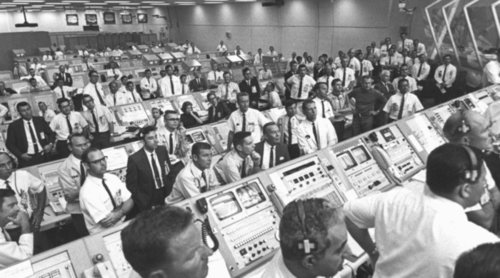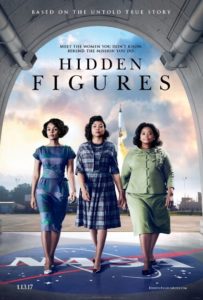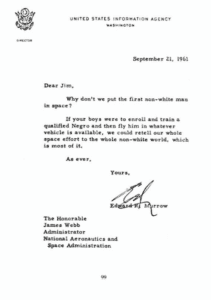


By Paul Kersey
12/08/2016
John Glenn’s passing at the age of 95 is just another reminder that the era of infinite possibility is sadly passing away. Glenn, a Marine fighter pilot in WWII and Korea, was the first American to orbit the earth in 1962. And with Glenn’s death goes the possibility of refuting one of the stranger tales born in the Current Year and poised to become the definitive story of the Mercury and Apollo missions: the Christmas Day-scheduled movie Hidden Figures’ “untold true story” that black women were the real force behind America’s space exploration.
In the book on which the movie is based, Hidden Figures: The American Dream and the Untold Story of the Black Women Mathematicians Who Helped Win the Space Race, by Margot Lee Shetterly, Glenn is quoted as having said this of Katherine Johnson, the black female brain allegedly behind NASA’s greatest glories.
"“Get the girl to check the numbers,” said the astronaut. If she says the numbers are good, he told them, I’m ready to go.”Glenn was supposedly asking for one more check before his flight into space — a review of the orbital trajectory generated by the IBM 7090 computer.
With Glenn’s death, we will never know if this conversation ever took place. But it is part of an insistent revisionist history of NASA [National Aeronautics and Space Administration], which was in fact almost entirely staffed by whites until the Apollo program was shuttered in the early 1970s.
Historians of the space program recognize the awful truth:
NASA, along with the companies that performed contract work during Apollo, was a reflection of society’s workforce in the late 1960s — mostly white, mostly male.[Apollo Moon Missions: The Unsung Heroes, by Billy Watkins,2006, p. 79]

But NASA’s website now reports that Katherine Johnson, a blue-eyed, light-skinned black female,
calculated the trajectory for Alan Shepard, the first American in space…even after NASA began using electronic computers, John Glenn requested that she personally recheck the calculations made by the new electronic computers before his flight aboard Friendship 7 — the mission on which he became the first American to orbit the Earth.”The primarily white Main Stream Media began frenetic virtue-signaling with the #OscarsSoWhite movement. This helped spawned a bidding war over the “true” story of how a lone black female helped fulfill John F. Kennedy’s promise of putting a man on the moon before the end of the 1960s:[Katherine Johnson: The Girl Who Loved to Count, NASA.gov, November 24, 2015]
But the recent canonization of Katherine Johnson and her “untold” contributions to NASA’s incredible achievements (think about it: the Wright brothers were the first humans to fly in 1903, NASA landed men on the moon only 66 years later) stretches credulity.
And Fox 2000 and Chernin are developing Hidden Figures, a movie about the African-American women who helped NASA launch its first space missions (Taraji P. Henson and Octavia Spencer recently were cast).
[Hollywood’s Casting Blitz: It’s All About Diversity in the Wake of #OscarsSoWhite, by Rebecca Ford, Hollywood Reporter, March 2, 2016]
A physicist, space scientist, and mathematician, Katherine Johnson gained a minute in the national glare in 1970 when she was instrumental in formulating calculations that helped the crippled Apollo 13 return home safely.Curiously, the Jet article acknowledges “very little literature documents African American women and their place in science”).U.S. Rep. Eddie B. Johnson Pushes Resolution To Support Black Women In Science & Technology

Why, perhaps most significantly, does Johnson not appear in Harlem Princess: The Story of Harry Delaney’s Daughter, the autobiography of Ruth Bates Harris? Harris, who took the job of Deputy Assistant Administrator for Equal opportunity for NASA in 1972, famously said, “I saw no minorities or women as astronauts. Could I help make a difference?" Harris waged a war to get more blacks involved with NASA, which was a paltry 5.6 percent non-white in 1973 versus a government agency average of 20 percent minority. [Societal Impact of Spaceflight, 2007, PDF]

September 21, 1961
Dear Jim,
Why don’t we put the first non-white man in space?
If your boys were to enroll and train a qualified Negro and then fly him in whatever vehicle is available, we could retell our whole space effort to the whole non-white world, which is most of it.
As ever,
Yours,
Edward R. Murrow
Just last year, after Katherine Johnson was awarded the Medal Of Freedom by President Obama, she named “West Virginian of the Year” and these strange words were written about her:
Johnson’s achievements, despite their significance, went largely unnoticed.Let’s be honest: the only “revisionist” history going on right now is the push to have Americans in 2016 believe a black woman was key to NASA’s putting a man on the moon.“No one knows that John Glenn wouldn’t fly unless Katherine Johnson checked the math,” Megan Smith, the White House chief technology officer, said in October. “It’s an amazing story, and it’s totally unknown.”
Johnson was never mentioned in the New York Times or the Washington Post before this year. She is nowhere to be found in ‘This New Ocean,’ NASA’s comprehensive internal history of Project Mercury.
Before 2015, the Charleston Gazette and Daily Mail wrote about her exactly once. The story appeared in the Gazette in 1977 to note that she had been honored by the Afro-American Historical and Cultural Museum in Philadelphia. It did not mention NASA. It was five sentences long.
“We’re in a country that sometimes we have revisionist history, and if you go look at history books, lots of times there aren’t African-Americans in there,” said Leland Melvin, a former space shuttle astronaut. “It’s so easy to just have an omission and play up the people and things that you want to make prominent.”
During the Mercury and Apollo missions, that meant playing up the stereotype of the first seven astronauts.
“Back then, you were a test pilot with a crew cut,” Melvin said. “The original seven, Life Magazine with the wives and the Corvettes — there wasn’t room for anyone else in that dialogue.”
[West Virginian of the Year: Katherine G. Johnson, Charleston Gazette Mail, by David Gutman, December 26, 2015. Link in original].
Minority Occupied America may not put men on the moon. But it can hype Politically Correct myths,
Paul Kersey is the author of the blog SBPDL, and has published the books SBPDL Year One, Hollywood in Blackface and Escape From Detroit, Opiate of America: College Football in Black and White and Second City Confidential: The Black Experience in Chicagoland. His latest book is The Tragic City: Birmingham 1963-2 013.